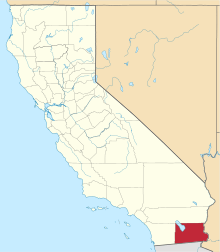Glamis, California
Glamis is an unincorporated community in Imperial County, California.[1] It is located 22 miles (35 km) northeast of Holtville,[2] at an elevation of 335 feet (102 m).[1]
Glamis | |
|---|---|
 | |
Glamis Location in California  Glamis Glamis (the United States) | |
| Coordinates: 32°59′51″N 115°04′19″W | |
| Country | United States |
| State | California |
| County | Imperial County |
| Elevation | 400 ft (102 m) |
Glamis (GLA-MIS) also mispronounced as (GLE-MIS), is one of a series of former Southern Pacific railroad stops along the eastern edge of the Algodones Dunes, located where the railway crosses State Route 78; other former stops in this area include Acolita, Clyde, Ruthven and Ogilby.
Glamis has virtually no permanent structures aside from the "Glamis Store" and "Boardmanville Trading Post". Both offer supplies; however, fuel is not available for some of the hundreds of thousands of recreational visitors each year (many of them ORV users) who pass through the Algodones Dunes and the associated Imperial Sand Dunes Recreation Area, located in the southern portion of the dune system. The name "Glamis" or "Glamis Dunes" is often used to refer to either or both of these areas, though technically this is incorrect.
Glamis's post office operated from 1886 to 1888, 1899 to 1901, 1917 to 1920, 1921 to 1923, and from 1940.[2] Glamis's ZIP code is 92283. The community was named for Glamis Castle in Scotland, which was made famous by the Shakespearean play Macbeth.[3]
Glamis is the closest community to the new Mesquite Regional Landfill, a waste-by-rail landfill being constructed for municipal trash primarily originating at the Puente Hills Intermodal Facility in Los Angeles County, and the Mesquite Mine, a gold mine.
References
- U.S. Geological Survey Geographic Names Information System: Glamis, California
- Durham, David L. (1998). California's Geographic Names: A Gazetteer of Historic and Modern Names of the State. Clovis, Calif.: Word Dancer Press. p. 1421. ISBN 1-884995-14-4.
- Gudde, Erwin Gustav (1960). California Place Names: The Origin and Etymology of Current Geographical Names. University of California Press.
